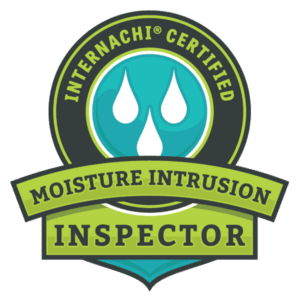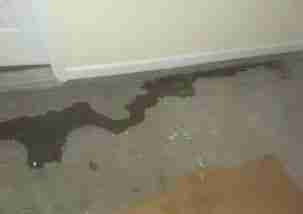Water Intrusion Inspections
in the Annapolis / Washington DC Area
Water Intrusion Inspections
Water Intrusion: How to See it, How to Stop it
Could your house be at risk for water damage?
Soil Grading
The direction in which rainwater flows is controlled by the slope of the land or grade around your house. Grounds that slope away from the property are best for avoiding excess water nearing the foundation. Fortunately, soil that slopes toward your house is not too hard to fix. If you choose to adjust the soil grade, a good rule of thumb is to follow the 6 by 10 guideline: slope soil away from the base structure or foundation by a height of 6 inches over 10 feet. A second technique is adding a swale: a shallow depression in the land that captures stormwater overflow and guides it towards a ditch or municipal drain. It is important to extend the bottom of the gutter downspouts away from the foundation into a drain, garden, or soil area which slants away from the property.

Landscape and Roots
Trees and plants around the house’s foundation efficiently regulate water saturation in the soil and add an extra layer of water damage protection. Leave openings among flowers to allow excess water to recede from the house. You can also install a catch basin and grates around downspouts to collect and redirect rainwater.
Foundation and Settling
If you see a crack in your walls or foundation, don’t panic. Cracks in foundations might be natural results of the house settling. They can also be symptoms of major issues. However, there are helpful tips to identify what sort of crack you may see in your foundation. When cracks are seen as benign, it is crucial to know what type of sealant to use on different surface areas. For a foundation crack, a concrete patching compound is ideal. For a joint crack, choose an exterior-grade caulk. A silicate-or urethane-based sealant is most suitable if you want to seal concrete.
Settling, or natural sinking and changes in a house’s foundation, is quite natural with changes in time and weather conditions. However, irregular settling can happen due to overly dry soil, triggering problems that are best ascertained early. Larger cracks made by foundation settling can allow water to permeate into the basement. Look for indications of settlement in walls and foundation, including large cracks that are noticeable both within and outside the home, larger than 1/8″ wide. These cracks extend diagonally. Look near windows and doors, near additions to the home, or where the load bearing of a home has been modified. If you see any damage that appears like horizontal cracking, it may be triggered by hydrostatic (water) pressure from the beyond walls and can cause foundation failure. Contact a structural engineer for better assessment and evaluation.
Importantly, do not patch or hide large cracks. This is the structural equivalent of putting a Band-Aid over a bullet wound. Ask a professional about the best and appropriate way to fix your particular crack; it may signify a greater structural issue.
Drains and Gutters
Sometimes, we just can’t tell where a house is constructed and how the grade will direct water toward it. Because of this, appropriate home drainage systems are vital to keeping water away from the house. There are drainage systems that can be easily installed and are simple and effective. A french drain is a drainage system installed around homes with very little pitch to the yard to get rid of standing water. A footing drain is a system placed around the foundation underneath the cellar flooring or slab to catch and guide away excess rainwater. When setting up a drain, only require the help of certified professionals who have the knowledge and competence to complete the installation properly.
Gutters are a water management system attached to the soffit or overhang of the home, which gathers water from the roofing and directs it away from your home. All houses must have gutters. The gutter system has leaders or downspouts which take the water from the gutters and direct it through and away from home. While it might be your least favorite seasonal task, cleaning out your gutters every six months will avoid buildup and overflow during rainstorms. Inspect rain gutters more often if you live in a thickly wooded area or every autumn. Cutting and trimming trees that hang over gutters will help prevent dirt and debris buildup.
Roofs, Flashing, and Siding
It is important to keep your roofing system, flashing, and siding clean to prevent the growth of algae, lichen, and moss. These organic unwanted growths encourage moisture which can cause rot and attract unwanted animals. Pressure washing the exterior of a house will prevent unwanted growth from persisting. Open spaces or gaps around windows or framing can be filled with caulk to close gaps where things might grow. During winter, snowbanks and ice damming on the roofing system can also undermine proper drainage. There are many solutions to this issue that, include heated gutter cables to melt ice and an attic fan controlled to take damp air out of the attic. One more sophisticated method is filling pantyhose with calcium chloride and ice melter and putting it on the roof overhanging the rain gutter.
Home Inspector Serving Baltimore, MD, And The Annapolis Metropolitan Area!
Water Intrusion: How to See it, How to Stop it
Could your house be at risk for water damage?
Soil Grading
The direction in which rainwater flows is controlled by the slope of the land or grade around your house. Grounds that slope away from the property are best for avoiding excess water nearing the foundation. Fortunately, soil that slopes toward your house is not too hard to fix. If you choose to adjust the soil grade, a good rule of thumb is to follow the 6 by 10 guideline: slope soil away from the base structure or foundation by a height of 6 inches over 10 feet. A second technique is adding a swale: a shallow depression in the land that captures stormwater overflow and guides it towards a ditch or municipal drain. It is important to extend the bottom of the gutter downspouts away from the foundation into a drain, garden, or soil area which slants away from the property.

Landscape and Roots
Trees and plants around the house’s foundation efficiently regulate water saturation in the soil and add an extra layer of water damage protection. Leave openings among flowers to allow excess water to recede from the house. You can also install a catch basin and grates around downspouts to collect and redirect rainwater.
Foundation and Settling
If you see a crack in your walls or foundation, don’t panic. Cracks in foundations might be natural results of the house settling. They can also be symptoms of major issues. However, there are helpful tips to identify what sort of crack you may see in your foundation. When cracks are seen as benign, it is crucial to know what type of sealant to use on different surface areas. For a foundation crack, a concrete patching compound is ideal. For a joint crack, choose an exterior-grade caulk. A silicate-or urethane-based sealant is most suitable if you want to seal concrete.
Settling, or natural sinking and changes in a house’s foundation, is quite natural with changes in time and weather conditions. However, irregular settling can happen due to overly dry soil, triggering problems that are best ascertained early. Larger cracks made by foundation settling can allow water to permeate into the basement. Look for indications of settlement in walls and foundation, including large cracks that are noticeable both within and outside the home, larger than 1/8″ wide. These cracks extend diagonally. Look near windows and doors, near additions to the home, or where the load bearing of a home has been modified. If you see any damage that appears like horizontal cracking, it may be triggered by hydrostatic (water) pressure from the beyond walls and can cause foundation failure. Contact a structural engineer for better assessment and evaluation.
Importantly, do not patch or hide large cracks. This is the structural equivalent of putting a Band-Aid over a bullet wound. Ask a professional about the best and appropriate way to fix your particular crack; it may signify a greater structural issue.
Drains and Gutters
Sometimes, we just can’t tell where a house is constructed and how the grade will direct water toward it. Because of this, appropriate home drainage systems are vital to keeping water away from the house. There are drainage systems that can be easily installed and are simple and effective. A french drain is a drainage system installed around homes with very little pitch to the yard to get rid of standing water. A footing drain is a system placed around the foundation underneath the cellar flooring or slab to catch and guide away excess rainwater. When setting up a drain, only require the help of certified professionals who have the knowledge and competence to complete the installation properly.
Gutters are a water management system attached to the soffit or overhang of the home, which gathers water from the roofing and directs it away from your home. All houses must have gutters. The gutter system has leaders or downspouts which take the water from the gutters and direct it through and away from home. While it might be your least favorite seasonal task, cleaning out your gutters every six months will avoid buildup and overflow during rainstorms. Inspect rain gutters more often if you live in a thickly wooded area or every autumn. Cutting and trimming trees that hang over gutters will help prevent dirt and debris buildup.
Roofs, Flashing, and Siding
It is important to keep your roofing system, flashing, and siding clean to prevent the growth of algae, lichen, and moss. These organic unwanted growths encourage moisture which can cause rot and attract unwanted animals. Pressure washing the exterior of a house will prevent unwanted growth from persisting. Open spaces or gaps around windows or framing can be filled with caulk to close gaps where things might grow. During winter, snowbanks and ice damming on the roofing system can also undermine proper drainage. There are many solutions to this issue that, include heated gutter cables to melt ice and an attic fan controlled to take damp air out of the attic. One more sophisticated method is filling pantyhose with calcium chloride and ice melter and putting it on the roof overhanging the rain gutter.
Home Inspector Serving Baltimore, MD, And The Annapolis Metropolitan Area!

Annapolis, MD is a great coastal town with some of the best seafood on the Atlantic. Among the great mix of opportunities you would discover in Annapolis, MD, and its surrounding areas, it is no surprise why over 39,000 locals call it their home. Annapolis also made its way to the list of some of the best sailing capitals in the world.
In making your most treasured investment where ensured complete satisfaction and peace of mind can be obtained for years, Dynamic Home Inspections, Inc. is here to help make your home purchase an informed and most confident one.
Instead of purchasing a house outright, putting your hard-earned money at the risk of running into monetary problems down the road, Dynamic Home Inspections, Inc. offers home inspection services that grant home buyers the information they need to make their most confident buying choice.
The team of pros – licensed and insured home inspectors of Dynamic Home Inspections, Inc. carries out with distinct levels of professionalism, utmost care, and attention to detail. Our services also include New Construction Inspections, Walk and Talk Consultations, 11th Month Builders Warranty, Radon Inspection, Mold Inspection, Sewer Scope Inspection, Structural, Electrical, Plumbing Inspections, and more. Serving home buyers and property owners in Annapolis, MD, and surrounding areas, our home inspection services have been sought for by several satisfied clients for years.
Call 410-989-8377 Today to Schedule Home Inspection Annapolis MD Online 24/7 Right From Our Website.





